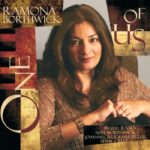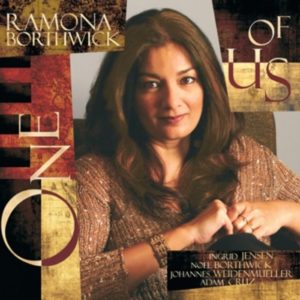ONE OF US | Ramona Borthwick, Leitmotif 2010
By RAUL d’GAMA ROSE, Editor, AAJ | January 17, 2010
The wonderful music of One of Us dwells on the interconnection of all things. Pianist Ramona Borthwick and her quartet make this happen on two important levels. First, they play from the same script as if they had studied the pages and came to make each their own in a very special and individual way. Second, there is a seamless connection between each of the songs and the quartet’s leader; Borthwick brings her considerable talent in weaving everything together with a secret gossamer thread. Both of these attributes speak volumes about the sensitivity with which each of the musicians handles the considerably—sometimes dense—material.
Ramona Borthwick proves that there is some depth among younger composers. Her bright work is agape at the immensity of all things. It appears that she looks at the world with childlike wonder, but is also privy to the true and deep nature of what she sees. This is reflected in the fluidity and the exquisite allure that is woven through each melody. Borthwick also leads and inspires colorful and artful harmonic invention throughout. She has a willing ally in trumpeter/flugelhornist Ingrid Jensen, whose memorable work here is absolutely magnificent; she plays each note as if it were her last. The result is solos like the music of dew on leaves—pristine, and each ringing with priceless wonderment.
Continue reading


 It is late afternoon, and I’m writing this article on a muggy, fall day in New York City’s Central Park. I’m seated on patchy grass after finding myself a hotspot (thanks to free wi-fi in the park), catching up on e-mail and news. I arrived here on the comfortable Acela train from Boston, three and a half hours of super-smooth travel that skirted the Eastern seaboard with barely a whisper. Since my arrival, I’ve been drawn into a gritty, urban state of mind, while savouring the ability to keep walking for hours, being simultaneously assaulted and lulled by the sights and sounds of Manhattan. In contrast, the park is an anticlimax – a green cocoon of quiet; free of exhaust and the taut energy that wraps the avenues outside. The purpose of my visit? None really. I have no appointments to keep, no deadlines to meet. I’m staying at the New Yorker Hotel, in midtown Manhattan. Built in the art deco style of the jazz swing era, it was one of NYC’s premier hotels and hosted famous big bands such as those led by Benny Goodman and Woody Herman during its heyday. Unfortunately it stands in various states of disrepair today, but its location is hard to beat, offering an almost instant access to several key tourist spots and vistas in the city core. Situated a few blocks north is Times Square and Central Park, and to the South, Lower Manhattan and the Village with its interesting, funky neighbourhoods such as SoHo, Chelsea, Little Italy and Chinatown.
It is late afternoon, and I’m writing this article on a muggy, fall day in New York City’s Central Park. I’m seated on patchy grass after finding myself a hotspot (thanks to free wi-fi in the park), catching up on e-mail and news. I arrived here on the comfortable Acela train from Boston, three and a half hours of super-smooth travel that skirted the Eastern seaboard with barely a whisper. Since my arrival, I’ve been drawn into a gritty, urban state of mind, while savouring the ability to keep walking for hours, being simultaneously assaulted and lulled by the sights and sounds of Manhattan. In contrast, the park is an anticlimax – a green cocoon of quiet; free of exhaust and the taut energy that wraps the avenues outside. The purpose of my visit? None really. I have no appointments to keep, no deadlines to meet. I’m staying at the New Yorker Hotel, in midtown Manhattan. Built in the art deco style of the jazz swing era, it was one of NYC’s premier hotels and hosted famous big bands such as those led by Benny Goodman and Woody Herman during its heyday. Unfortunately it stands in various states of disrepair today, but its location is hard to beat, offering an almost instant access to several key tourist spots and vistas in the city core. Situated a few blocks north is Times Square and Central Park, and to the South, Lower Manhattan and the Village with its interesting, funky neighbourhoods such as SoHo, Chelsea, Little Italy and Chinatown.  [This article was published in the August 2007 issue of the Qatar-based feature magazine ‘New Era’.]
[This article was published in the August 2007 issue of the Qatar-based feature magazine ‘New Era’.] [This article was published in the May 2007 issue of the Qatar-based feature magazine ‘New Era’.
[This article was published in the May 2007 issue of the Qatar-based feature magazine ‘New Era’. 